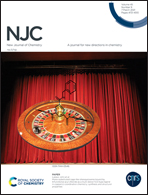Three in one sensor: a fluorometric, colorimetric and paper based probe for the selective detection of mercury(ii)†
Abstract
In this work, a 3,4-ethylenedioxythiophene and tetrahydrophenazine based donor–acceptor–donor-type conjugated molecule was used for the first time as a turn-off fluorescence sensor for the detection of mercury (Hg2+) ions. Eleven metal ions (As3+, Cd2+, Cu2+, Fe2+, Fe3+, Hg+, Hg2+, K+, Ni2+, Se4+ and Zn2+) were tested and the proposed sensor exhibited almost 100% quenching in the fluorescence emission only when interacting with Hg2+ ions. Moreover, the sensor changed its color from yellow to blue upon Hg2+ addition, which indicates that the sensor is not only a fluorescence sensor but also a chromogenic sensor for Hg2+ detection. The solid state behavior was tested by preparing a simple paper-based sensor, and complete fluorescence quenching in the presence of Hg2+ was successfully obtained. The stoichiometry between the sensor and Hg2+ was found to be 1 : 1. The limit of detection (LOD) and the practical quantitation limit (PQL) were calculated to be 8.0 ppm and 26.3 ppm, respectively. The sensor was found to be more sensitive under acidic conditions, and the LOD decreased up to 3.0 ppm in the pH range of 1.6–2.3.



 Please wait while we load your content...
Please wait while we load your content...